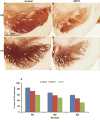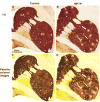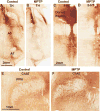Chronic MPTP administration regimen in monkeys: a model of dopaminergic and non-dopaminergic cell loss in Parkinson's disease
- PMID: 28861737
- PMCID: PMC5826821
- DOI: 10.1007/s00702-017-1774-z
Chronic MPTP administration regimen in monkeys: a model of dopaminergic and non-dopaminergic cell loss in Parkinson's disease
Abstract
Parkinson's disease (PD) is a progressive neurodegenerative disorder clinically characterized by cardinal motor deficits including bradykinesia, tremor, rigidity and postural instability. Over the past decades, it has become clear that PD symptoms extend far beyond motor signs to include cognitive, autonomic and psychiatric impairments, most likely resulting from cortical and subcortical lesions of non-dopaminergic systems. In addition to nigrostriatal dopaminergic degeneration, pathological examination of PD brains, indeed, reveals widespread distribution of intracytoplasmic inclusions (Lewy bodies) and death of non-dopaminergic neurons in the brainstem and thalamus. For that past three decades, the MPTP-treated monkey has been recognized as the gold standard PD model because it displays some of the key behavioral and pathophysiological changes seen in PD patients. However, a common criticism raised by some authors about this model, and other neurotoxin-based models of PD, is the lack of neuronal loss beyond the nigrostriatal dopaminergic system. In this review, we argue that this assumption is largely incorrect and solely based on data from monkeys intoxicated with acute administration of MPTP. Work achieved in our laboratory and others strongly suggest that long-term chronic administration of MPTP leads to brain pathology beyond the dopaminergic system that displays close similarities to that seen in PD patients. This review critically examines these data and suggests that the chronically MPTP-treated nonhuman primate model may be suitable to study the pathophysiology and therapeutics of some non-motor features of PD.
Keywords: Acetylcholine; Extra-striatal dopamine; MPTP monkey; Nigrostriatal dopamine; Norepinephrine; Parkinson’s disease; Serotonin; α-Synuclein.
Conflict of interest statement
No conflicts of interest, financial or otherwise, are declared by the authors.
Figures





Similar articles
-
AAV1/2-induced overexpression of A53T-α-synuclein in the substantia nigra results in degeneration of the nigrostriatal system with Lewy-like pathology and motor impairment: a new mouse model for Parkinson's disease.Acta Neuropathol Commun. 2017 Feb 1;5(1):11. doi: 10.1186/s40478-017-0416-x. Acta Neuropathol Commun. 2017. PMID: 28143577 Free PMC article.
-
The nigrostriatal system in the presymptomatic and symptomatic stages in the MPTP monkey model: a PET, histological and biochemical study.Neurobiol Dis. 2012 Oct;48(1):79-91. doi: 10.1016/j.nbd.2012.05.018. Epub 2012 Jun 5. Neurobiol Dis. 2012. PMID: 22677034
-
RANTES-induced invasion of Th17 cells into substantia nigra potentiates dopaminergic cell loss in MPTP mouse model of Parkinson's disease.Neurobiol Dis. 2019 Dec;132:104575. doi: 10.1016/j.nbd.2019.104575. Epub 2019 Aug 22. Neurobiol Dis. 2019. PMID: 31445159 Free PMC article.
-
Back and to the Future: From Neurotoxin-Induced to Human Parkinson's Disease Models.Curr Protoc Neurosci. 2020 Mar;91(1):e88. doi: 10.1002/cpns.88. Curr Protoc Neurosci. 2020. PMID: 32049438 Review.
-
Neuroprotective and Therapeutic Strategies against Parkinson's Disease: Recent Perspectives.Int J Mol Sci. 2016 Jun 8;17(6):904. doi: 10.3390/ijms17060904. Int J Mol Sci. 2016. PMID: 27338353 Free PMC article. Review.
Cited by
-
Early onset of sleep/wake disturbances in a progressive macaque model of Parkinson's disease.Sci Rep. 2022 Oct 19;12(1):17499. doi: 10.1038/s41598-022-22381-z. Sci Rep. 2022. PMID: 36261689 Free PMC article.
-
The importance of social behavior in nonhuman primate studies of aging: A mini-review.Neurosci Biobehav Rev. 2023 Nov;154:105422. doi: 10.1016/j.neubiorev.2023.105422. Epub 2023 Oct 6. Neurosci Biobehav Rev. 2023. PMID: 37806369 Free PMC article. Review.
-
New insights in animal models of neurotoxicity-induced neurodegeneration.Front Neurosci. 2024 Jan 8;17:1248727. doi: 10.3389/fnins.2023.1248727. eCollection 2023. Front Neurosci. 2024. PMID: 38260026 Free PMC article. Review.
-
Initial Molecular Mechanisms of the Pathogenesis of Parkinson's Disease in a Mouse Neurotoxic Model of the Earliest Preclinical Stage of This Disease.Int J Mol Sci. 2024 Jan 22;25(2):1354. doi: 10.3390/ijms25021354. Int J Mol Sci. 2024. PMID: 38279354 Free PMC article.
-
Spatiotemporal scaling changes in gait in a progressive model of Parkinson's disease.Front Neurol. 2022 Dec 13;13:1041934. doi: 10.3389/fneur.2022.1041934. eCollection 2022. Front Neurol. 2022. PMID: 36582611 Free PMC article.
References
-
- Airaksinen MS, Thoenen H, Meyer M. Vulnerability of midbrain dopaminergic neurons in calbindin-D28k-deficient mice: lack of evidence for a neuroprotective role of endogenous calbindin in MPTP-treated and weaver mice. Eur J Neurosci. 1997;9:120–127. - PubMed
-
- Akil M, Lewis DA. The distribution of tyrosine hydroxylase-immunoreactive fibers in the human entorhinal cortex. Neuroscience. 1994;60:857–874. - PubMed
Publication types
MeSH terms
Grants and funding
LinkOut - more resources
Full Text Sources
Other Literature Sources
Miscellaneous

